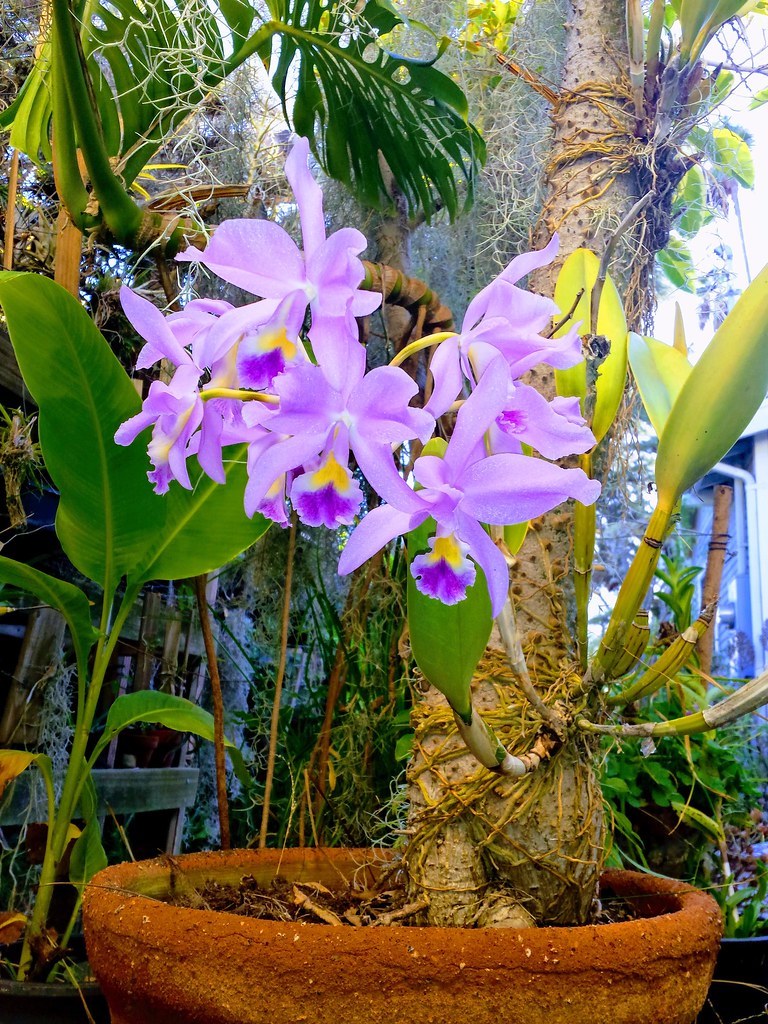In a recent thread a member was unhappy that his potted Aloe has a trunk. My suggestion was to attach miniature epiphytes to it. Stone Jaguar had a few issues with my suggestion. Rather than address them in that thread, I figured I'd create a thread on the topic.
In many cases less is more. But, from my perspective, this has never been the case with plants. I've never attended a show and thought, "this show needs less plants". I've never visited a nursery and thought, "this nursery needs less plants". I've never visited a garden and thought, "this garden needs less plants". I've never seen a tree and thought, "this tree needs less epiphytes".
Epiphytes are wonderful because more plants can be added without sacrificing any horizontal space. For example, I have a Pachypodium lamerei growing in my front yard. A few years ago I attached a Dendrobium (discolor x canaliculatum) orchid to it. In this way I added another plant to my front yard without using up any more of my horizontal space. In this short and pretty terrible video you can see that I'm not the only one happy with the addition.
Stone Jaguar brought up the point about disparities in water requirements. This is an important point. It's why I didn't choose a cloud forest orchid but instead chose an orchid with parents from seasonally dry forests. There are a ton of orchid species from seasonally dry forests... and countless hybrids have been made with them. Here are some pics of orchids growing on cactus and other succulent plants in the wild and in cultivation. There are also plenty of bromeliads, especially Tillandsias, that are from seasonally dry forests. It's generally the case that, if these epiphytes experience cooler temps in nature, it's going to be during the dry season.
I grow hundreds of different drought tolerant epiphytes outdoors year around here in SoCal. During winter they can go weeks without water. The humidity here is relatively low and I'm pretty far from the coast so fog/mist isn't significant.
Stone Jaguar also brought up a point about purity. Pachypodium lamerei is from Madagascar while the parents of the Dendrobium growing on it are from Australia. I'm less interested in showcasing plants that do grow together in nature and more interested in showcasing plants that can grow together in cultivation. In my blog entry I gave the example of Polystachya ottoniana naturally growing on Cussonia spicata. If somebody wants to combine them in cultivation then that's great! But I really don't see the benefit of limiting potential partners based on something arbitrary like geography. Plus, there are far more potential foreign hosts than native hosts so chances are good that any given epiphyte will prefer growing on a foreign host...
It clearly wouldn't be beneficial for epiphytes to limit themselves to native hosts. So I don't think that we should impose this limit on them or ourselves.Angraecum praestans is mainly found in dry forest rich in succulents like Euphorbia, Aloe, Pachypodium and Diospyros, where it either grows as an epiphyte in semi-shade or as a lithophyte. It has adopted the introduced Tamarind (Tamarindus indica) as a favourite host. - Johan Hermans
That being said, I can't say that I'm the biggest fan of Tillandsias being attached to shells! I have nothing against shells... it's just that I'd much prefer seeing Tillandsias attached to Aloes and other plants. The combination is far more interesting because it's far more dynamic. The epiphyte and its host are growing together. How well are they growing together? How well do they complement each other? Is the whole greater than the sum of its parts? If so, how much greater is it?
Here's a recent pic I took of a Cattleya hybrid blooming on my potted Floss Silk Tree...

Ceiba Phorobana by Epiphyte, on Flickr
From my perspective, the whole is greater than the sum of its parts. The chances are really slim though that this is best epiphyte for this host and vice versa. I don't think it would be very difficult to pick a better epiphyte for a potted Ceiba. But it would certainly be very challenging to pick the very best epiphyte for a potted Ceiba. Not only would you have to know about the Ceiba's requirements, but you'd have to know about the requirements of countless potential epiphytes. Conversely, picking the best host for the Cattleya would depend on knowing the requirements of countless potential hosts.
Growing a nice Aloe in a pot takes a decent amount of skill and knowledge. But it would take even more skill and knowledge to grow a nice Aloe phorobana.
